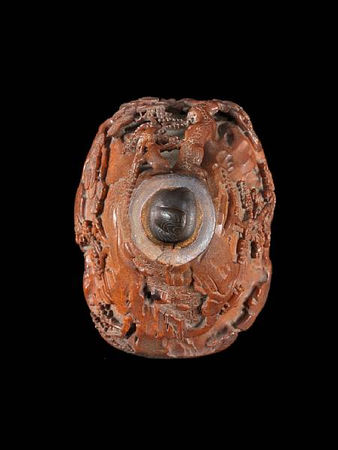A finely-carved rhinoceros horn libation cup. Kangxi
A finely-carved rhinoceros horn libation cup. Kangxi. photo Bonhams
Intricately carved around the exterior with a continuous riverscape, containing a single standing scholar amidst large rocky outcrops, overhanging pine and wutong trees, the openwork handle in the form of further gnarled pine and wutong trunks reaching over the rim, the horn of an attractive honey-brown tone. 10.3cm x 13.5cm x 10.3cm. Estimate: £100,000 - 150,000, HKD 1,300,000 - 1,900,000, $ 160,000 - 240,000
Provenance: James Whitbread Lee Glaisher (1848-1928), the prolific English mathematician and lecturer at Cambridge University. He bequeathed his extensive collection of Far Eastern, Islamic, English and Continental pottery to the Fitzwilliam Museum in Cambridge in 1928.
An English private collection
James Whitbread Lee Glaisher. photo Bonhams
Rhinoceros horn carvings were already very well-established and sought after by the early Qing Dynasty. We know that in the mid-Kangxi period, a skilled carver from Wuxi, known as Rhinoceros Cup You, was summoned to work for the Court. Furthermore, we know that three rhinoceros horn libation cups from the Sloane Collection and now in the British Museum, London, were acquired in Europe prior to 1683. This illustrates that by the late 17th century fine examples of rhinoceros horn were not only highly sought after, but were also available to foreign buyers.
Rhinoceros horn libation cups depicting single, or groups of scholars, within idealised landscapes clearly take their inspiration from painted handscrolls. The form of the libation cup, swirling waters and open-work pine handle are very comparable to another Kangxi period libation cup, formerly in the Thomas Fok collection, inscribed Sheng Fugong (reputed to be a late Ming period carver) and Wenshu cang (The collection of Wenshu), illustrated by T.Fok, Connoisseurship of Rhinoceros Horn Carving in China, Hong Kong, 1999, fig.160. It was subsequently sold at Christie's Hong Kong, 31 May 2010, lot 1808. The incisions in the horn to depict the swirling waters are also comparable to another landscape libation cup, similarly depicting a single scholar, in the Avery Brundage Collection in the Asian Art Museum of San Francisco, illustrated by J.Chapman, The Art of Rhinoceros Horn Carving in China, London, 1999, fig.275. See also a related Kangxi period rhinoceros horn libation cup from the Alphonse Servais Collection sold at Christie's London, 9 November 2010, lot 54.
Bonhams. Fine Chinese Art, 12 May 2011, New Bond Street www.bonhams.com

/https%3A%2F%2Fprofilepics.canalblog.com%2Fprofilepics%2F1%2F0%2F100183.jpg)
/https%3A%2F%2Fstorage.canalblog.com%2F03%2F02%2F119589%2F96711876_o.jpg)
/https%3A%2F%2Fstorage.canalblog.com%2F11%2F31%2F119589%2F94773502_o.jpg)
/https%3A%2F%2Fstorage.canalblog.com%2F20%2F83%2F119589%2F94772815_o.jpg)
/https%3A%2F%2Fstorage.canalblog.com%2F26%2F72%2F119589%2F75604929_o.jpg)
/https%3A%2F%2Fstorage.canalblog.com%2F59%2F60%2F119589%2F26458628_o.jpg)








/http%3A%2F%2Fstorage.canalblog.com%2F79%2F84%2F119589%2F121121505_o.png)
/http%3A%2F%2Fstorage.canalblog.com%2F80%2F42%2F119589%2F120611565_o.jpg)
/http%3A%2F%2Fstorage.canalblog.com%2F79%2F49%2F119589%2F113206128_o.jpg)
/http%3A%2F%2Fstorage.canalblog.com%2F80%2F78%2F119589%2F113206111_o.jpg)